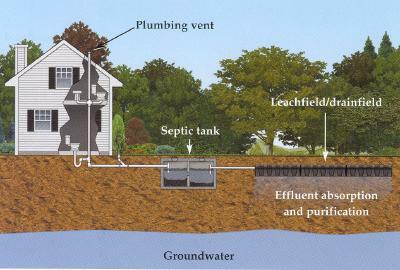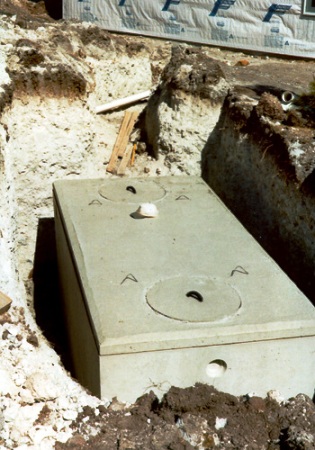
Going with the flow: Septic tanks combine physics and biology to breakdown waste.
Talk about sticker shock!
When Glendora Realtor Marty Rodriguez and her neighbor inquired about replacing their 30-year-old septic tanks and connecting their ranch-style homes to the city sewer system, they got an estimate for $150,000, or $75,000 apiece. Despite the exorbitant estimate, they decided to green-light the project.
“It would cost even more to repair the septic system,” said her son Sean Rodriguez, who is overseeing the project.
The septic system was installed in 1980 when Marty built her custom home in the Glendora foothills. Over the years, the in-ground 1,500-gallon tank has slowly decomposed and the solids that have accumulated in her septic system have proved increasingly stubborn to pump and flush out. To try to extend the life of her current septic system would be like sticking a Band-Aid on a broken leg. The leach lines and seepage pits that support her septic system also drain poorly in the heavy clay soil and require extensive repairs.
As a Realtor, Marty is doubly aware of alerting her buyers to potential septic system problems. Currently, in the United States, about 25% of the population relies on septic tanks, including many homeowners living in the San Gabriel Valley.
A Time Bomb Waiting to Go Off?
“You may go 30 years without having a problem, but it only has to happen one time for you to have a big bill on your hands,” Marty said. “That’s why it so critical that a fully certified inspector specializing in septics and sewers signs off on the system before a homebuyer takes possession of the property.”
Glendora plumber Mike Albo said the inspection should involve more than popping off the cap and shining a flashlight inside the septic tank.
“Ask the inspector what his experience is,” Albo said. “A careful, conscientious inspector will check the plugs, crawl up in the attic or under the house if it’s on a raised foundation. They may run cameras down lines. They’ll check how quickly water drains out of your sinks and bathtubs, and your leach lines and cesspools as well.”
The thorough testing often will reveal potential trouble spots that the prospective homebuyer needs to know about before deciding to move ahead with the transaction.
“The cost of replacement is huge … it’s huge,” said Albo, his eyes widening. “It’s big. It’s something you’re not going to be happy about.”
At first blush, replacing or repairing a compromised septic system doesn’t seem that it should be so costly. A septic tank is nothing more than a small-scale sewage treatment system common in areas with no connection to main sewage pipes provided by local governments or, in lesser cases, private corporations.
The septic tank is sort of like the fuel filter for your car; you have to keep the gunk and residue out or pretty soon you’re going to have a problem,” said Tom McCoy, owner of A&D Drain and Pumping Service, with offices in San Dimas and Ontario.
How a Septic Tank Works
A septic tank generally consists of a tank (or sometimes more than one tank) of between 1,000 and 2,000 gallons in size connected to an inlet wastewater pipe at one end and a septic drain field at the other. These pipe connections are generally made via a T pipe, which allows liquid entry and exit without disturbing any crust on the surface. Today, the design of the tank usually incorporates two separately capped chambers, which are separated by a dividing wall, with openings located about midway between the floor and roof of the tank.

Soon this septic tank will be covered up so that it can discreetly go about its business.
Wastewater enters the first chamber of the tank, allowing solids to settle and scum to float. Bacteria begin digesting and reducing the volume of solids. The liquid component flows through the dividing wall into the second chamber where further settlement takes place, with the excess liquid then draining in a relatively clear condition from the outlet into the leach field, also referred to as a drain field or seepage field, depending upon locality.
The remaining impurities are trapped and eliminated in the soil, with the excess water eliminated through percolation into the soil, eventually returning to the groundwater through evaporation, and by uptake through the root systems of plants.
The age-old technology is simple enough, but nature often dictates the cost of repair and replacement for which there is no reliable book of suggested prices. “There is no norm,” anymore,” Albo said.
“Building a seepage pit is like building a well,” McCoy noted. “You could go down 12 feet or as far down as 60 feet. Similarly, a leach field could start out as a four-foot trench and deepen to a 10-foot trench, depending on the pitch of the land and the soil and other factors.”
Big Expense
If both soil compaction and percolation tests are required, more expense is involved.
“The percolation test runs about $2,500,” McCoy said. “The soil analysis is about $4,000. A special kind of geologist has to do it. It’s kind of a closed market. Hopefully, the city is on the ball, so they’ve already done soil testing in your area.”
Adding to costs are potential water table issues and jurisdictional disputes between city and county ownership of the land and sewer connections.
Although plumbers answer many fairly routine calls for service, the truth is they never fully know what to expect. Their investigations can take them down many different paths (and pipes).
“If I know they’re on a septic, the first question I ask, “Albo said, is ‘When was the last time you had your septic tank pumped?’” A&D charges $235 to pump out a septic tank, about half the cost going to the dump site operator. “Our fees just went up another 5% as of July 1,” McCoy said.
Amazingly, many homeowners don’t even know if they’re on a septic system. “I run into about 20 calls a year like that,” McCoy said. “They’ve never had a problem, so they never inquired.”
Usually, some easy detective work will reveal a stopped-up or overflowing septic tank. Foul odors are another give away, but not always. “A lot of septic tanks are buried, and the homeowner doesn’t have a clue where they are,” Tom said. “It’s not unusual to find some buried under driveways.”
Albo recently answered a call from a Glendora homeowner, whose kitchen sink wouldn’t drain. After probing around, he discovered that the kitchen sink was hooked up to a septic tank while the rest of the house, including the pool, was connected to the city sewer.
“It took me a while to figure out,” said Albo, who ended up running a line from the kitchen sink to the main line connecting to the sewer. “The current owner didn’t know that the original owner had never hooked one up. It can happen.”
Treat with Care
Of course, septic systems would probably endure far longer if they were treated with a little more care and respect – not as the exclusive dumping grounds for mom’s day-old casserole.
“Don’t deposit coffee grounds, cooking fats, wet-strength towels, disposable diapers, facial tissues, cigarette butts, and other non-decomposable materials into your house sewer,” Albo said. “These materials won’t decompose and will fill the septic tank and plug the system.
“If you must use a garbage disposal, you will likely need to remove septic tank solids every year or more often. Ground garbage will likely find its way out of the septic tank and plug up the drainfield. It is better to compost or deposit the materials in the garbage to be hauled away.”
Household chemicals, including detergents and bleaches, can be unfriendly to septic systems, as well. That’s because excessive amounts can actually arrest the growth of good bacteria needed to breakdown the solid waste material inside the tank.
“I try to steer my customers away from using a lot of anti-bacterial agents like bleach and Lysol,” McCoy said. “Instead, use disinfectant wipes and cleaners to wipe down your surfaces and then discard them in the trash.”
To promote waste-eating bacteria colonies inside the septic tank, there are myriad remedies that have been suggested. “I was told — but never tried it — to put a raw chicken inside the septic tank,” Albo said.
McCoy, meanwhile, recommended adding brewer’s yeast to encourage bacteria growth.
“Activate it first in some warm water,” McCoy said. “Then drop it in the toilet.”
Despite their finicky temperaments, septic systems have many advocates. McCoy said a well-functioning septic system is more ecologically sound than a sewer hook-up because the filtration works like a meadow or marsh naturally recycling the gray water back into the environment. It’s no accident that the root systems of flowers and trees closest to the septic system often flourish the most. “The roots travel to where water and nutrients are,” McCoy said. Those same lush roots, however, can breach septic tanks and leach lines and cause further havoc.
Albo, like Marty, simply wants homebuyers to be aware of the current household sewer system they’re inheriting before they sign a purchase contract.
“I’m always amazed that when people go shopping for a house they don’t ask the big questions, like, ‘What shape is the roof in?’ or ‘How’s the plumbing?’” Albo said, laughing. “But most people don’t look at that. They say, ‘Oh, look at the nice cabinets or the granite countertops.’ But if their plumbing sucks, what good is the house?”
Rodriguez said she makes certifying the plumbing system, including septic/sewer, priority No. 1. “You just want to know what you’re dealing with,” Marty said. “You want to be able to advise your home buyer correctly. If your client has five kids and wants to buy a home from a couple of empty nesters whose home is on a septic system, I want to know if that septic system can support that larger family.
“I don’t want any septic surprises for my clients,” she added. “I know how expensive these fixes can be!”
RESOURCES
Mike Albo Plumbing:



Leave a Reply